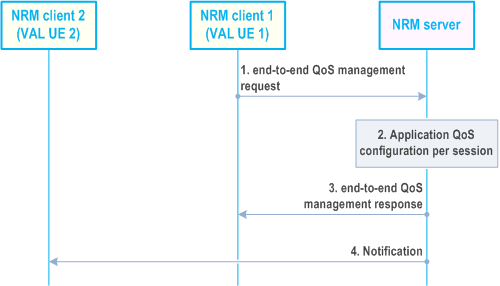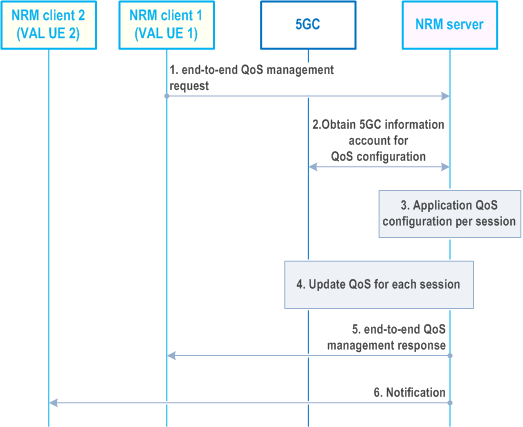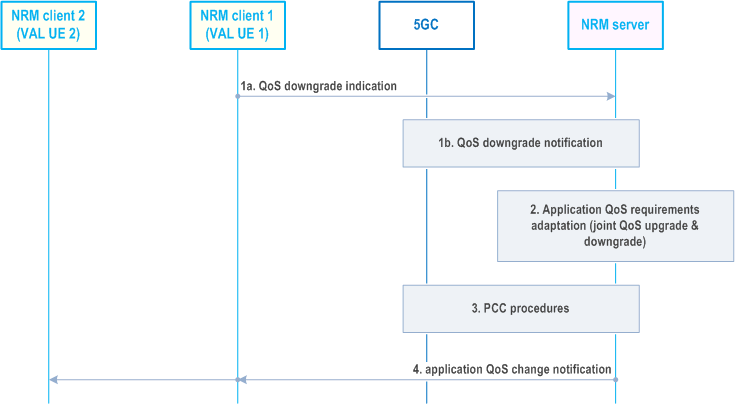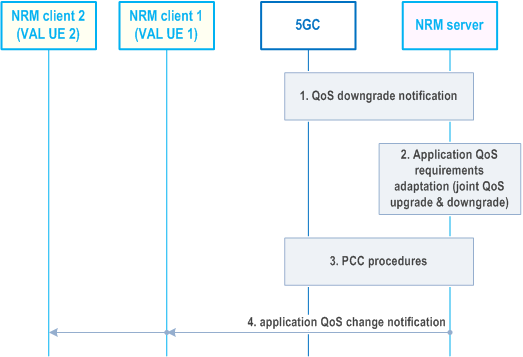Content for TS 23.434 Word version: 19.2.0
0…
4…
5
6…
6.4…
6.5…
6.5.3…
7…
8…
8.2.2…
9…
9.3…
9.3.2.21…
9.3.3…
9.3.6…
9.3.11…
9.3.13…
9.3.14…
9.4…
9.4.6…
9.5…
10…
10.3…
10.3.2.22…
10.3.3…
10.3.7…
10.3.10…
10.4…
11…
11.3…
11.3.3…
11.4…
12…
12.3…
13…
14…
14.2.2.2…
14.3…
14.3.2.20…
14.3.2.40…
14.3.3…
14.3.3.3…
14.3.4…
14.3.4.6
14.3.4.7…
14.3.4A…
14.3.4A.3…
14.3.4A.4…
14.3.4A.6…
14.3.4A.8…
14.3.4A.9…
14.3.4A.10…
14.3.5…
14.3.6…
14.3.9…
14.3.12…
14.4…
15…
16…
17…
18…
A
B…
14.3.5 QoS/resource management for network-assisted UE-to-UE/VN group communications
14.3.5.1 General
14.3.5.2 QoS/resource management capability initiation in network assisted UE-to-UE communications
14.3.5.2.1 Procedure for a single pair of UEs
14.3.5.2.2 Procedure for a group of UEs
14.3.5.3 Procedure for coordinated QoS provisioning operation in network assisted UE-to-UE communications
14.3.5.3.1 Procedure for a single pair of UEs
14.3.5.3.2 Procedure for a group of UEs
...
...
14.3.5 QoS/resource management for network-assisted UE-to-UE/VN group communications |R17| p. 246
14.3.5.1 General p. 246
This feature provides the SEAL NRM support for coordinated QoS/resource management for network assisted UE-to-UE communications. Such capability may be required for guaranteeing end-to-end QoS fulfilment (primarily for meeting end-to-end latency requirements) in network assisted UE to UE communications and may accommodate various vertical-specific application services, e.g.:
- Network-assisted Command and Control (C2) communications in UASAPP (TS 23.255), where the UAV controller navigates its UAV over the 5GS;
- Teleoperated Driving (ToD) in eV2XAPP (TS 23.286), where the a V2X UE acting as server may remotely control a further V2X UE over the 5GS;
- Network-assisted Device-to-Device communications in Factory of the Future (FF) use cases, such as control-to-control communications.
- 5G LAN-Type communication within a 5G VN group as specified in TS 23.501.
14.3.5.2 QoS/resource management capability initiation in network assisted UE-to-UE communications p. 246
This procedure provides a mechanism for initiating the capability at the NRM server for managing the end-to-end application QoS requirement fulfilment for a network-assisted VAL UE to VAL UE session (comprising a PDU session for each of the constituent links, e.g. VAL UE 1 to PLMN, and PLMN to VAL UE 2). The request may come from NRM client of either of the VAL UEs within the service and will trigger the end-to-end QoS/resource management by the NRM server. The triggering the end-to-end QoS management request can be initiated by the VAL application at the VAL UE, and the conditions may depend on the requirements of the VAL service, e.g. for UAS such triggering may be needed when a UAV is in-flight, or for V2X such trigger may be initiated when a controlled VAL UE enters an urban area, or for 5G LAN-type service such trigger may be initiated by the AF (e.g. on VAL UE1) that manages the corresponding 5G VN group.
The clause 14.3.5.2.1 describes the end-to-end QoS/resource management capability for network-assisted UE-to-UE communications for a single pair of UEs.
The clause 14.3.5.2.2 describes the end-to-end QoS/resource management capability for network-assisted UE-to-UE communications for a group of UEs.
14.3.5.2.1 Procedure for a single pair of UEs p. 246
Figure 14.3.5.2.1-1 illustrates the procedure where the NRM server is initiating the end-to-end QoS/resource management capability for network-assisted UE-to-UE communications for a single pair of UEs.
Pre-conditions:
- The NRM client is connected to the NRM server.
- The VAL UEs involved in the end-to-end session (VAL UE 1 and VAL UE 2) are connected to one or more PLMNs and have ongoing PDU sessions.
- NRM server has used the "Setting up an AF session with required QoS procedure" (clause 4.15.6.6 of TS 23.502).

Step 1.
The NRM client 1 (of VAL UE 1) sends to the NRM server an end-to-end QoS management request for managing the QoS for the end-to-end application session.
Step 2.
The NRM server configures the application QoS parameters by decomposing the end-to-end QoS requirements (VAL UE 1 to VAL UE 2) to application QoS parameters for each individual session (e.g. network session for VAL UE 1 -and network session for VAL UE 2) which are part of the end-to-end application session.
Step 3.
The NRM server sends to the NRM client 1 an end-to-end QoS management response with a positive or negative acknowledgement of the request.
Step 4.
The NRM server may also send a notification to NRM client 2 (of VAL UE 2) to inform about the end-to-end QoS management initiation by the NRM server.
14.3.5.2.2 Procedure for a group of UEs |R18| p. 247
Figure 14.3.5.2.2-1 illustrates the procedure where the NRM server is initiating the end-to-end QoS/resource management capability for network-assisted UE-to-UE communications for a group of UEs.
Pre-conditions:
- The NRM client is connected to the NRM server.
- The VAL UEs involved in the end-to-end session (VAL UE 1 and a group of VAL UEs) are connected to one or more PLMNs and have ongoing PDU sessions.

Step 1.
The NRM server receives from the AF on NRM client 1 (of VAL UE 1) the end-to-end QoS management request for managing the QoS on UE-to-UE traffic for a group of UEs.
Step 2.
The NRM server retrieves from 5GC or subscribe to 5GC to obtain additional VAL-UE associated information for each member in the group identified by the VAL group ID, which is account for decomposition. The VAL-UE associated information could be from the 5GC (NEF Monitoring Events as in TS 23.502, QoS sustainability analytics as in TS 23.288) or SEAL LMS (on demand location reporting).
Step 3.
The NRM server configures the application QoS parameters by decomposing the end-to-end QoS requirements (UE-to-UE traffic for any two UEs in a group) to application QoS parameters for each individual session (uplink network session for ingress group member and downlink network session for egress group member). The NRM server needs to take the additional VAL-UE associated information into account for evaluation during such decomposition.
Step 4.
The NRM/SEAL server, acting as AF, sends to the 5GC a "Procedures for AF requested QoS for a UE or group of UEs not identified by a UE address" to set the application QoS parameters respectively for uplink network session for each ingress group member in the group and for downlink network session for egress group member.
Additionally, the NRM/SEAL server may activate monitoring of the performance to receive QoS monitoring event notifications from 5GC by setting the (optionally with Alternative QoS Profiles) in the request, in this case the AF may receive the QoS downgrade notification for e.g. latency thus to initiate the NRM-assisted coordinated QoS provisioning for 5G LAN-Type communication in clause 14.3.5.3.x
Step 5.
The NRM server sends to the NRM client 1an end-to-end QoS management response with a positive or negative acknowledgement of the request.
Step 6.
If the NRF server receives the end-to-end QoS management request including VAL UE2 as any of the List of VAL UEs, then the NRM server may also send a notification to NRM client 2 (of VAL UE 2) to inform about the end-to-end QoS management initiation by the NRM server.
14.3.5.3 Procedure for coordinated QoS provisioning operation in network assisted UE-to-UE communications p. 248
This procedure provides a mechanism for ensuring the end-to-end application QoS requirement fulfilment for the application service (which is between two or more VAL UEs), considering that the QoS of one of the links may downgrade. It is assumed that the application session is ongoing, and both the source and target VAL UEs are connected to 3GPP network (the same or different). The communication between the VAL UEs is assumed to be in-direct / network-assisted; hence two PDU sessions are established respectively (one per VAL UE).
The clause 14.3.5.2.1 describes the end-to-end QoS/resource management capability for network-assisted UE-to-UE communications for a single pair of UEs.
The clause 14.3.5.2.2 describes the end-to-end QoS/resource management capability for network-assisted UE-to-UE communications for a group of UEs.
14.3.5.3.1 Procedure for a single pair of UEs p. 248
Figure 14.3.5.3.1-1 illustrates the procedure where the NRM server supports the coordinated QoS provisioning for network-assisted UE-to-UE communications for a single pair of UEs.
Pre-conditions:
- NRM server has activated the end-to-end QoS/resource management capability, as described in 14.3.5.2.1
- NRM server, acting as AF, has registered to receive QoS monitoring event notifications from 5GC and notifications from VAL UEs (from both UEs), as specified in TS 23.501.

Step 1a.
A QoS downgrade trigger event is sent from the NRM client of the VAL UE 1 to the NRM server, denoting an application QoS degradation (experienced or expected) e.g. based on the experienced packet delay or packet loss for the Uu link (e.g. packet loss great than threshold value). The conditions for triggering the QoS downgrade indication from the NRM client is based on the threshold that may be provided in advance by the NRM server (at the end-to-end QoS management response by the NRM server in 14.3.5.2.1).
Step 1b.
Alternatively, the NRM server receives a trigger event from the 5GC (SMF/NEF), denoting a QoS downgrade notification for the VAL UE 1 session. (described in clause 5.7.2.4.1b of TS 23.501).
Step 2.
The NRM server evaluates the fulfilment/non-fulfilment of the end-to-end QoS based on the trigger event. NRM server may retrieve additional information based on subscription to support its evaluation. This could be from the 5GC (NEF Monitoring Events as in TS 23.502, QoS sustainability analytics as in TS 23.288) or SEAL LMS (on demand location reporting for one or both VAL UEs 1 and 2).
Then, the NRM server, determines an action, which is the QoS parameter adaptation of one or both links (QoS profile downgrade for the link receive QoS notification control, and QoS upgrade for the link which can be upgraded).
Step 3.
The NRM/SEAL server, acting as AF, sends to the 5GC (to SMF via NEF or to PCF via N5) a request for a change of the QoS profile mapped to the one or both network sessions (for VAL UE 1 and UE 2) or the update of the PCC rules to apply the new traffic policy (as specified in clause 4.15.6.6a of TS 23.502: AF session with required QoS update procedure).
Step 4.
The NRM server sends an application QoS change notification to the affected NRM clients, to inform on the adaptation of the QoS requirements for the individual session.
14.3.5.3.2 Procedure for a group of UEs |R18| p. 249
Figure 14.3.5.3.2-1 illustrates the procedure where the NRM server supports the coordinated QoS provisioning for network-assisted UE-to-UE communications.
Pre-conditions:
- NRM server has activated the end-to-end QoS/resource management capability, as described in clause 14.3.5.2.1.
- NRM server, acting as AF, has registered to receive QoS monitoring event notifications from 5GC and notifications from VAL UEs (from any UEs in a group), as specified in TS 23.501.

Step 1.
The NRM server receives a trigger event from the 5GC (SMF/NEF), denoting a QoS downgrade notification for the network session of any group member in a group. (described in clause 5.7.2.4.1b of TS 23.501).
Step 2.
The NRM server evaluates the fulfilment/non-fulfilment of the end-to-end QoS based on the trigger event. NRM server may retrieve additional information based on subscription to support its evaluation. This could be from the 5GC (NEF Monitoring Events as in TS 23.502, QoS sustainability analytics as in TS 23.288) or SEAL LMS (on demand location reporting for one or both VAL UEs 1 and 2).
Then, the NRM server, determines an action, which is the QoS parameter adaptation of only uplink/downlink network session or both uplink and downlink network sessions for each ingress group member in the group.
Step 3.
The NRM/SEAL server, acting as AF, sends to the 5GC (to SMF via NEF or to PCF via N5) a request for a change of the QoS profile mapped to the impacted network sessions or the update of the PCC rules to apply the new traffic policy (as specified in clause 4.15.6.14 of TS 23.502: AF requested QoS for a UE or group of UEs not identified by a UE address procedure).
Step 4.
The NRM server sends an application QoS change notification to the affected NRM clients, to inform on the adaptation of the QoS requirements for the individual session.